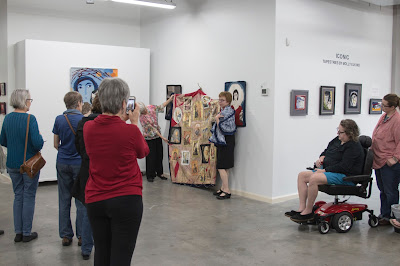If I've done my job right (smile, wink), many of you are already aware that a solo show of my tapestries just opened at
Southeast Fiber Arts Alliance (SEFAA) just outside Atlanta. I admit, I've been pretty much consumed by the weaving and other preparations for this show for
months years. Today, now that the show is up, I want to share why I think
every artist/maker/craftsperson should aim for a solo show of their work at some point.
10. Let's get this one out of the way right off: it is a nice ego boost to see your name, maybe not in lights, but on the wall. We toil along in solitude in our studios, mostly, and it just feels great to get yourself and your work out in the light of day.
 |
| title wall of exhibi |
9. It's great to share your work online, through websites and emails and social media--and I love all that--but nothing beats getting it in front of actual humans. Yesterday I got to talk with people IRL about their responses to the work, hear their questions and their responses, and that was so good.
8. You will make or deepen your contacts and connections with the folks at your gallery or venue, and also with other artists, potential viewers and collectors. In the art biz as in every other biz, networking is really important. I am incredibly grateful for the support of the folks at
SEFAA and that of my artist friends in pulling this together. Specifically, Linda DeMars' and Marilyn Kleinhans' suggestions
way improved my initial plan when we hung the show together. Thank you!
 |
| hanging with Marilyn Kleinhans (left) |
 |
| hanging with Linda DeMars |
7. Other people--family, friends, fellow artists, potential buyers--will see your commitment to your own work and respect you for it. You demonstrate to them (and yourself) that you are a serious artist. (For more on the difficult path toward calling yourself an artist, see
Kathleen Loomis' excellent recent post.)
6. Once you commit, a year or two out, to having the show, then you actually buckle down and make the work! Nothing is so motivating as a deadline and a commitment to someone else. And when you're done, you have a coherent body of work that you created with intention. For the record, I have eight pieces in the Mary series and six in the illuminated manuscript series. This body of work is now available for juried show entries, other exhibits, and potential sales (who knows?).
5. Your artistic growth accelerates. Again, once you've set the goal, you get busy solving artistic problems, improving your technique, figuring out what it is exactly you are after in your work. While I know I still have much to learn, my understanding of how different yarns behave, for example, improved a great deal between the first Mary piece. . .
 |
| detail, Mary (a sword shall pierce), (c) 2013, Molly Elkind |
and the last one:
 |
| detail, Mary (Yes), (c) 2018 Molly Elkind |
Or between the earliest illuminated manuscript piece:
 |
| Huh? (c) 2016, Molly Elkind |
and the lateest one. . .
 |
Red Letter Night, (c) 2018, Molly Elkind
|
4. You will get serious also about writing and updating your artistic resume, your inventory (see
previous post for more on this) and mailing lists (email and snail mail). It can be tempting to let this stuff slide sometimes. . . but when you have all your paperwork ducks in a row you are ready when opportunities knock. And they will, because with a solo show in the works, you are a Serious Artist.
3. You will learn to speak and write with confidence about your work. You will get your elevator speech down cold. This has been one of the most challenging parts for me. I've stumbled and hemmed and hawed trying to explain why I'm fascinated with such arcane subjects as the Virgin Mary, illuminated manuscripts, and tapestry itself.
It's SO important though, because people want to understand, and they need you to give them some clues and a starting point. I'm going to give an artist talk at the reception for the show, but for those who miss that, I've installed a mockup of my design wall, with some of the quotes, sketches, images, yarn cards and samples that I used in developing the work in the exhibit. I hope it helps clarify not only my subject matter but the tapestry process a bit as well.
 |
| design wall at Iconic: Tapestries by Molly Elkind |
2. You will hone your time management skills. You will start to plan your days, if you don't already, around the studio time you require to get the work made, rather than trying to find creative time after you've done everything else (and you're tired, to boot). Your priorities shift.
1. And for the Number One reason why you should do a solo show. . . Well, you tell me! If you feel like it, please share in the comments below.
Now, what are you waiting for?





























